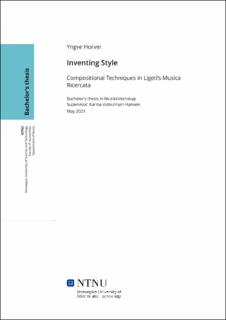| dc.contributor.advisor | Karina Valnumsen Hansen | |
| dc.contributor.author | Yngve Horvei | |
| dc.date.accessioned | 2023-07-06T17:19:31Z | |
| dc.date.available | 2023-07-06T17:19:31Z | |
| dc.date.issued | 2023 | |
| dc.identifier | no.ntnu:inspera:145107873:93398472 | |
| dc.identifier.uri | https://hdl.handle.net/11250/3076880 | |
| dc.description.abstract | Denne oppgaven utforskar verket Musica Ricercata for solopiano av den ungarske komponisten György Ligeti, skrive i 1951-1953. Verket var skrive tidleg i komponistens karriere, og på den tida da hans eksperimentelle stil ikkje var fullt utviklet. På grunn av at Ungarn var ein satellittstat i Sovjetunionen på den tida, hadde landet ein streng kulturpolitikk som forbød nokre musikalske stilar, særskilt dei som var knytt til Vesten og eksperimentalisme. Dette førte til at stykket, på grunn av sin eksperimentelle natur, ikkje vart offentleg framført før 16 år etter det vart komponert.
Stykket har 11 satsar, og den første av dei nyttar berre to tonehøgdeklasser; den andre nyttar tre tonehøgdeklasser, og dette mønsteret gjentek seg til alle 12 tonehøydeklasser er i bruk i siste sats. Denne eksperimentelle tilnærminga kom frå at Ligeti ynskja å definere sin eigen stil "ut av ingenting", både for å finne sin eiga stemme som komponist i motsetnad til hans tidlege påvirkninger, og sannsynlegvis også som ein opprørshandling i regimet.
I denne teksten analyserer eg Musica Ricercata sats for sats for å oppdage teknikkane som definerte denne stilen og resulterte frå desse eksperimentane. Både i korleis dei påverkar verket og dets estetiske og musikalske kvalitetar, samt korleis dei bidrog til Ligetis seinere komposisjonsstil. | |
| dc.description.abstract | This thesis explores the work Musica Ricercata for solo piano by Hungarian composer György Ligeti, written in 1951-1953. The work was written early in the composer’s career, and at the time when his experimental style was not fully developed. Due to Hungary being a satellite state of the Soviet Union at the time, the country had a strict cultural policy forbidding certain musical styles, particularly those associated with the West and experimentalism. This led to the piece, due to its experimental nature, not being publicly performed until 16 years after its conception.
The piece has 11 movements, of which the first only uses two pitch classes; the second uses three pitch classes, and this pattern repeats itself until all 12 pitch classes are in use in the final movement. This experimental approach came from Ligeti wanting to define his own style “out of nothing”, both to find his own voice as a composer as opposed to that of his early influences, and likely also as an act of rebellion in the regime.
In this text, I analyse Musica Ricercata movement for movement in order to discover the techniques that defined this style and resulted from this experiments. Both in how they effect the work and its aesthetic and musical qualities, as well as how they contributed to Ligeti’s later compositional style. | |
| dc.language | eng | |
| dc.publisher | NTNU | |
| dc.title | Inventing Style: Compositional Techniques in Ligeti’s Musica Ricercata | |
| dc.type | Bachelor thesis | |
